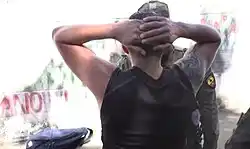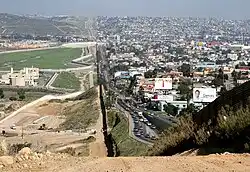Central American migrant caravans are large caravans or groups of political refugees and economic migrants that have traversed through Central America for much of the early twenty-first century, often looking to enter the United States. While migration to the US is a centuries old process, in recent decades the places of origins of those looking to migrate to the country have changed considerably. Many are coming from countries like Nicaragua, El Salvador, Guatemala and Honduras that have experienced very serious issues around crime, violence and economic and political instability in modern times, while others are coming from further afield in Venezuela and Colombia, two countries riven by internal struggles and hyperinflation in Venezuela’s case. As the number of those crossing Central America towards Mexico and the US has increased dramatically, these migrant caravans have become more systematically organized, often containing thousands of people. Hundreds of thousands of migrants have arrived to the US and Mexico via Central American migrant caravans since the turn of the millennium.[1]
Research your ancestors on MyHeritage
Central American migrant caravans chronology of eventsCentral American migrant caravans chronology of events
There is nothing new about people migrating in large numbers to the US. Between the advent of mass European immigration to the Americas after the end of the Napoleonic Wars in 1815 and the passage of the Immigration Act of 1924, tens of millions of people from countries as varied as Ireland, Scotland, Italy, Poland, Germany, Romania and Norway arrived to the US. For much of the remainder of the century migrants arrived from regions like Cuba, Indochina and the Korean Peninsula that became some of the frontlines of the Cold War. Perhaps the greatest twentieth-century source of US migrants was Mexico, with the Mexican Revolution of the 1910s set a precedent for large numbers of Mexicans to simply cross the border to Texas, New Mexico, Arizona or California. Thus, migration to the United States is nothing new, but the identity of those arriving and where they are coming from has changed considerably over time.[2]

The Central American migrant caravans are symptomatic of this. A huge proportion of the migrants arriving to the US in the early twenty-first century are coming from Central or South America. Honduras, El Salvador, Guatemala and Nicaragua have experienced revolutions, political and economic instability and, in some cases, striking levels of violence occasioned by the rise of criminal gangs in recent decades. Colombia experienced a decades-long conflict between groups like FARC, the Medellin Cartel and the government. More recently, an economic crisis in Venezuela spiralled into hyperinflation in the mid-2010s which has seen millions of Venezuelans flee from their homeland. All of these issues have created upwards of twenty million migrants across Central America and the countries on the northern end of South America.[3]
Many of these migrants have determined to try and seek political asylum or a better life in the United States and the last quarter of a century has witnessed a large northward migration towards the southern border of the United States. Many people travel in small groups, but over time many people have banded together into larger caravans of migrants. In Central America this has taken on an unusual shape since the mid-2000s, as groups there have begun organizing migrant caravans of hundreds or thousands of migrants. Migrants pay the organizers of these caravans hundreds or thousands of dollars to convey them over a large stretch of territory. Often these caravans are organized by criminal organizations of the very kind which are responsible for destabilizing many of the countries involved.[4]
Extent of Central American migrant caravansExtent of Central American migrant caravans

Migrant caravans only account for a proportion of the wave of migration from parts of South and Central America northwards to Mexico and the United States. It is difficult to assess exactly how many people are involved, for the simple reason that these are not officially sanctioned caravans, but are typically illegal entities. What is clear anecdotally is that dozens of migrant caravans, often consisting of as many as 6,000 or 7,000 people, are traversing from countries like Nicaragua and Guatemala north through Central America and Mexico to the US border.[5] Many have come from further afield, having made the Darien Gap crossing from Colombia though Panama to Central America. This means that there are tens of thousands of migrants crossing the region as part of organized caravans every year and most years that figure is rising into the hundreds of thousands.[6]
Demographic impact of the Central American migrant caravansDemographic impact of the Central American migrant caravans
While the same problems of establishing precise figures pertain to establishing the demographic impact of the Central American migrant crossings, there is no doubt that the wider phenomenon of migration from Central America and countries like Colombia, Venezuela and Ecuador in South America over the last thirty to forty years has been vast in the demographic changes it has brought about. There are, for instance, nearly fifty million people living in the United States today that were not born in the US, over 14% of the population. Only a proportion of these have arrived to the US via Central American migrant caravans, but it has been a contributory cause.[7]
Though the US dominates international headlines in this respect, all of those who successfully transit through Central American as part of the caravans arrive to Mexico before they come to the US. In years and decades to come, a large number of people in the US and Mexico will have an ancestor who migrated away from the crippling circumstances in their home countries in Central America and South America as part of Central American migrant caravans.[8]
See alsoSee also
Explore more about the Darien Gap crossingsExplore more about the Darien Gap crossings
- Colombia, Baptisms, 1630-1950 records collection on MyHeritage
- Colombia, Marriages, 1750-1960 records collection on MyHeritage
- Venezuela Voter Lists, 2006-2007 records collection on MyHeritage
- Ecuador, Baptisms, 1680-1930 records collection on MyHeritage
- Ecuador, Marriages, 1680-1930 records collection on MyHeritage
- Honduras, Baptisms, 1730-1930 records collection on MyHeritage
- Honduras, Marriages, 1800-1910 records collection on MyHeritage
- Nicaragua, Civil Registration, 1809-2011 records collection on MyHeritage
- Costa Rica, Birth Index, 2011-2015 records collection on MyHeritage
- El Salvador, Baptisms, 1750-1940 records collection on MyHeritage
- El Salvador, Marriages, 1810-1930 records collection on MyHeritage
- El Salvador, Civil Registration, 1815-1910 records collection on MyHeritage
References
- ↑ https://www.bakerinstitute.org/research/migrant-caravans-deep-dive-mass-migration-through-mexico-and-effects-immigration-policy
- ↑ https://www.history.com/topics/immigration/immigration-united-states-timeline
- ↑ https://www.cfr.org/article/why-six-countries-account-most-migrants-us-mexico-border
- ↑ https://usmex.ucsd.edu/_files/TheMigrantCaravan-FromHondurastoTijuana-August2019.pdf
- ↑ https://www.bakerinstitute.org/research/migrant-caravans-deep-dive-mass-migration-through-mexico-and-effects-immigration-policy
- ↑ https://www.cfr.org/article/crossing-darien-gap-migrants-risk-death-journey-us
- ↑ https://www.pewresearch.org/short-reads/2024/09/27/key-findings-about-us-immigrants/
- ↑ https://www.migrationpolicy.org/article/mexico-crossroads-emigration-transit

